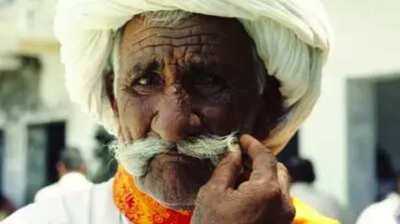
Historical Significance of the Moustache in RajasthanFor centuries, Rajasthani men have sported long and well-maintained moustache, considering them an essential part of their identity. In Rajput culture, warriors often grew their moustache as a sign of valor. A well-groomed moustache was associated with power, dominance, and respect. The Rajput rulers, who were known for their courage and chivalry, proudly maintained their moustaches, signifying their unwavering spirit and defiance against foreign rule.

One of the most famous historical figures who upheld this tradition was Maharaja Jai Singh II, the ruler of Jaipur. Known for his intelligence, valor, and strong Rajput identity, he stood against Mughal Emperor Aurangzeb's imposition of strict regulations on Rajput rulers, which included trimming their moustache as a sign of submission. However, Jai Singh II refused to bow to these demands. According to historical accounts, when he visited the Mughal court, he ensured that his moustache was prominently groomed upwards, signifying his resistance to Mughal dominance. This act was seen as a statement of sovereignty and defiance, emphasizing that Rajput rulers would not be subdued.

Moustache as a Symbol of Status and HonourIn Rajasthan, a moustache is not merely facial hair but a statement of prestige and power. The bigger and more elaborate the moustache, the greater the honour it commands. It is often considered a mark of masculinity, maturity, and social standing. Even today, in many Rajasthani communities, men take great pride in their moustaches, and growing one is often associated with self-respect and familial pride.
This belief is not confined to Rajasthan alone. In certain Marathi communities, a similar tradition exists where sons refrain from shaving their moustache during their father's lifetime. This practice emphasizes the moustache as a marker of maturity and respect within the family hierarchy. A popular belief in Rajasthan states that a man should not shave his mustache as long as his father is alive. This myth is rooted in the deep respect and reverence for elders in Rajasthani society. This belief is still followed in some traditional families, though modernity has led to a shift in perspectives.
Moustache in Warfare and Resistance MovementsThroughout history, Rajput warriors took immense pride in their moustache. During battles, it was common for Rajput soldiers to sport long moustache as a symbol of fearlessness. The moustache was considered an extension of their honour, and many warriors would rather die on the battlefield than surrender and be forced to shave it off.
During British rule in India, Rajputs continued to regard their moustache as a symbol of defiance. Many British officers, recognizing the importance of moustache among Rajput warriors, even attempted to adopt the style themselves. However, in Rajasthan, the moustache remained a deeply rooted cultural and traditional aspect of identity that no foreign influence could erase.

Modern-Day Relevance of Moustache in RajasthanDespite changing times and modern influences, the moustache remains a cherished cultural symbol in Rajasthan. Whether in villages or royal courts, it continues to be a proud emblem of tradition, honour, and heritage. In various rural communities, men still maintain their moustache as a mark of self-respect, and competitions celebrating the longest or most well-groomed moustache are frequently held at cultural fairs, including the famous Pushkar Camel Fair. These events showcase the continued reverence for moustache in Rajasthani society.
Even in contemporary Indian cinema and popular culture, the Rajasthani moustache has been glorified as a sign of regal masculinity. Many Bollywood films depicting Rajasthani or Rajput characters highlight thick, upward-curled moustache as an essential part of the protagonist’s persona. Actors playing Rajput warriors, kings, or traditional Rajasthani men often sport elaborate moustache, reinforcing their cultural significance.

The moustache in Rajasthan is much more than an aesthetic choice; it is a legacy of honour, tradition, and defiance. It has stood the test of time, symbolizing bravery from the era of Rajput warriors to modern-day cultural representations. Whether worn by kings, warriors, or commoners, the moustache remains an emblem of Rajasthani pride, connecting generations through its deep historical and cultural roots. In a rapidly changing world, the moustache continues to stand as a timeless testament to Rajasthan’s rich and valiant heritage.
 Historical Significance of the Moustache in RajasthanFor centuries, Rajasthani men have sported long and well-maintained moustache, considering them an essential part of their identity. In Rajput culture, warriors often grew their moustache as a sign of valor. A well-groomed moustache was associated with power, dominance, and respect. The Rajput rulers, who were known for their courage and chivalry, proudly maintained their moustaches, signifying their unwavering spirit and defiance against foreign rule.
Historical Significance of the Moustache in RajasthanFor centuries, Rajasthani men have sported long and well-maintained moustache, considering them an essential part of their identity. In Rajput culture, warriors often grew their moustache as a sign of valor. A well-groomed moustache was associated with power, dominance, and respect. The Rajput rulers, who were known for their courage and chivalry, proudly maintained their moustaches, signifying their unwavering spirit and defiance against foreign rule.



